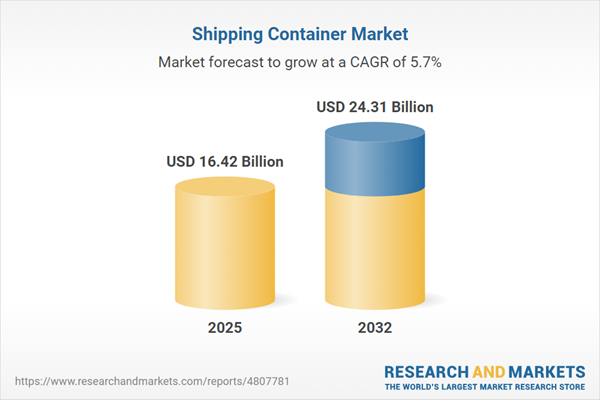Speak directly to the analyst to clarify any post sales queries you may have.
The shipping container market is rapidly evolving as global supply chains adapt to digital transformation, decarbonization, and trade realignments. Senior leaders seeking a competitive edge require multifaceted insight into emerging technologies, sustainability pressures, and the broader shipping container ecosystem.
Market Snapshot: Size, Growth, and the Road Ahead
The shipping container market grew from USD 15.62 billion in 2024 to USD 16.42 billion in 2025 and is projected to continue expanding at a CAGR of 5.68%, reaching USD 24.31 billion by 2032. This sustained growth is underpinned by accelerating digital integration, evolving regional trade patterns, and mounting environmental expectations across maritime logistics.
Scope & Segmentation of the Shipping Container Market
- Container Types: Dry containers remain the cornerstone for general cargo; refrigerated containers support rising demand for cold-chain and temperature-sensitive goods; specialized containers serve oversized and high-security shipments; ISO tanks and flat racks address project and chemical logistics.
- Material Types: Steel continues to dominate for durability; aluminum is selected for lightweight needs; fiber-reinforced polymer solutions address corrosion risk and niche requirements in extreme environments.
- Container Sizes: Offerings range from compact 20ft units for regional activity to industry-standard 40ft mediums, high-cube containers for e-commerce and automotive logistics, and flat racks tailored to non-standard cargoes.
- Ownership Models: Carrier owned fleets align with mainline vessel operations, while shipper owned units enable greater control and flexibility for end-users across trade routes.
- Applications: Key industries addressed include chemicals, electronics, consumer goods (both durable and non-durable), food & beverage, healthcare (including pharmaceuticals and medical devices), agriculture, machinery, automotive, energy and petroleum, industrial goods, and retail flows.
- Regional Coverage: Comprehensive analysis spans the Americas (North America and Latin America), Europe, Middle East & Africa, and Asia-Pacific, detailing strategic nodes from deepwater ports to inland distribution corridors.
- Leading Companies Analyzed: The report details latest developments, innovations, and operational strategies among firms including China International Marine Containers (Group) Ltd., DCM Hyundai Limited, Singamas Container Holdings Limited, Sea Box Inc., CXIC Group Containers Company Limited, and others.
Key Takeaways for Senior Decision-Makers
- The primary keyword "shipping container market" frames a landscape where container standardization, digital adoption, and lifecycle optimization shape operational advantage.
- Technological advancements, such as IoT sensors, blockchain-enabled cargo traceability, and real-time visibility solutions, are redefining asset utilization and cost models in logistics networks.
- Shifts toward composite materials, modular container platforms, and advanced coatings directly support industry efforts to reduce environmental footprints and comply with evolving regulatory mandates.
- Regional dynamics—from Asia-Pacific's automation and manufacturing clusters to Latin America's port modernization—create differentiated opportunities and require region-specific strategies to maximize throughput and minimize risk.
- Operators navigating increasing sustainability requirements must balance lifecycle management, collaborative asset pools, and digital innovation to maintain competitive differentiation and meet customer expectations.
Tariff Impact: New U.S. Trade Measures and Strategic Response
With the introduction of expanded U.S. tariffs on shipping container imports in 2025, global trade lanes are experiencing pronounced cost and flow shifts. Carriers and logistics planners are recalibrating network layouts, leveraging alternative ports in Canada and Mexico, and revisiting hub-and-spoke infrastructure to offset rising duties. These trade policy changes are driving equipment sourcing strategies and incentivizing regional manufacturing approaches for high-value and temperature-controlled units.
Methodology & Data Sources
The report's findings reflect rigorous primary interviews with shipping lines, leasing executives, port authorities, and regulators, triangulated with secondary sources from industry publications and government filings. Extensive modeling integrates proprietary terminal throughput records, vessel tracking logs, and equipment lifecycle benchmarks.
Why This Report Matters
- Gain in-depth segmentation analysis, enabling targeted product and investment decisions for specific customer groups and trade patterns.
- Understand regulatory, technological, and regional factors reshaping competitive dynamics in the global shipping container sector.
- Leverage evidence-based insights to optimize procurement, asset lifecycle management, network design, and sustainability strategy.
Conclusion
Senior stakeholders will benefit from a clear, actionable understanding of the shipping container domain’s new realities. This report serves as a critical tool for informed decision-making and strategic planning in an ever-shifting logistics landscape.
Additional Product Information:
- Purchase of this report includes 1 year online access with quarterly updates.
- This report can be updated on request. Please contact our Customer Experience team using the Ask a Question widget on our website.
Table of Contents
3. Executive Summary
4. Market Overview
7. Cumulative Impact of Artificial Intelligence 2025
Companies Mentioned
The companies profiled in this Shipping Container market report include:- Ab Sea Container Private Limited
- APPL Containers Pvt. Ltd.
- China Eastern Containers
- China International Marine Containers (Group) Ltd.
- CXIC Group Containers Company Limited
- DCM Hyundai Limited
- Dong Fang International Container Co. Ltd.
- IWES Ltd.
- J K Technologies Private Limited
- Kalyani Cast Tech Pvt. Ltd.
- KEN Containers
- OEG Offshore Limited
- Ritveyraaj Cargo Shipping Containers
- Sea Box Inc.
- Silversea Container
- Singamas Container Holdings Limited
- Thurston Group
- TLS Offshore Containers International Pvt Ltd
- Valisons & Co.
- W&K Containers Inc.
Table Information
| Report Attribute | Details |
|---|---|
| No. of Pages | 188 |
| Published | November 2025 |
| Forecast Period | 2025 - 2032 |
| Estimated Market Value ( USD | $ 16.42 Billion |
| Forecasted Market Value ( USD | $ 24.31 Billion |
| Compound Annual Growth Rate | 5.6% |
| Regions Covered | Global |
| No. of Companies Mentioned | 21 |









